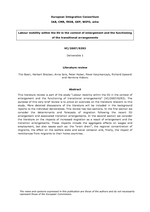Labour Mobility Study
Labour Mobility - Background Analyses - Analysis of the scale, direction and structure of labour mobility
Herbert Brücker and Andreas Damelang
in: Labour Mobility - Background analyses
Labour Mobility Study ,
This background report is part of the study "Labour mobility within the EU in the context of enlargement and the functioning of transitional arrangements" (VC/2007/0293). The objective of this report is to provide an overview on the main patterns of labour migration in the context of the EU Eastern enlargement and on the fundamental economic forces which cause these patterns.
The income gap between the EU-15 and the new member states from Central and Eastern Europe is larger than in previous enlargement rounds. In particular, the nominal gap in per capita GNI and wage levels is high, reflecting poor capital endowments and particularly large productivity differences in the tradable sectors. Although economic incentives to migrate are considerable at present, we also observe a fast convergence of per capita GDP and wage levels which mitigate migration incentives over time.
Particularly wages have converged very fast since the enlargement. Convergence between the EU-15 and the new member states is faster than convergence between the EU-15 and the candidate countries in South-Eastern Europe. Transport costs have declined since enlargement and depend less on geographical distance. This may be one of the reasons for the fast shift in migration away from destinations neighbouring the new member states toward destinations such as Ireland, the UK and Spain.
The stock of foreign residents from the NMS-8 in the EU-15 has increased from 893,000 persons in 2003 to about 1.91 million persons in 2007, or by 254,000 persons p.a. The number of foreign residents from Bulgaria and Romania has increased from 702,000 to about 1.86 million persons during the same period of time, or by 290,000 persons p.a. This increase in migration is associated with a shift in the regional structure of migration, i.e. away from Austria and Germany towards Ireland and the UK in case of migrants from the NMS-8, and towards Spain and Italy in case of migrants from Bulgaria and Romania. Migrants from the NMS are highly concentrated at the medium level of the skill spectrum, i.e. in the group with a vocational training degree. They are highly concentrated in the young age groups. The unemployment risk of migrant workers from the NMS is slightly higher than that of the native labour force in the EU-15 on average, but below that of the main other foreigner groups in the EU.
Countries covered: European Union, New EU Member States
Research Areas: Labour, Migration and Income Distribution
